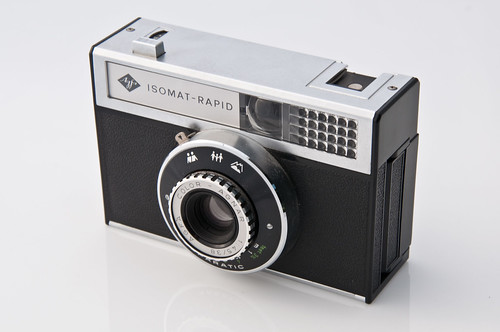Difference between revisions of "Isomat Rapid"
m |
m (doubled word) |
||
| Line 15: | Line 15: | ||
For flash exposure (using the included [[hot shoe]]), a tab on the side of the lens permits manual selection of apertures; the shutter speed switches to approximately 1/30th of a second, to accommodate the burning time of bulb flashes. | For flash exposure (using the included [[hot shoe]]), a tab on the side of the lens permits manual selection of apertures; the shutter speed switches to approximately 1/30th of a second, to accommodate the burning time of bulb flashes. | ||
| − | The Isomat Rapid takes advantage of an advanced feature of the [[rapid film]] standard, namely its film speed index tab. When a photographer purchased a fresh | + | The Isomat Rapid takes advantage of an advanced feature of the [[rapid film]] standard, namely its film speed index tab. When a photographer purchased a fresh roll of Agfa Rapid film, it would come loaded into a cassette indexed with a tab of the appropriate [[film speed]], allowing those Rapid cameras so equipped to adjust their meter readings. This was accomplished via a silver metal plate affixed to the side of the cassette, whose central tab was shorter for slow films and longer for fast ones. (Empty cassettes of any speed could be used in the film take-up compartment: the emulsion type of an exposed Rapid roll was indicated by punched markings in the tail of the film.) |
Rapid loads were standard perforated 35mm film, so today's photographer does not find it too daunting to reload them in a darkroom; but the speed-index system does create the extra headache of locating (or modifying) empty Rapid cassettes with the correct tab length. | Rapid loads were standard perforated 35mm film, so today's photographer does not find it too daunting to reload them in a darkroom; but the speed-index system does create the extra headache of locating (or modifying) empty Rapid cassettes with the correct tab length. | ||
Revision as of 15:44, 23 June 2011

|
| Agfa Isomat-Rapid (1965 -1969) image by Hans Jan Dürr (Image rights) |
This 1965 introduction is one of Agfa's series of squared-off, largely plastic cameras made for their easy-loading Rapid film system. It outwardly resembles Agfa's other simple fixed-focus Rapid models like the Iso-Rapid I; and like those, it gives 16 exposures of 24×24 mm square per roll. A count-down frame counter indicates exposures remaining, and interlocks only allow the shutter to fire with the back closed and film advancing. (The shutter locks again after the last exposure on a roll.)
But the Isomat Rapid is a more sophisticated model, with weightier body and a scale-focusing, three-element Color-Agnar 38mm f/4.5 lens. While one might assume that the "fly eye" panel beside the viewfinder was a dummy meter, this was a true selenium cell, which controls the aperture that the (diamond-shaped) lens aperture closes to as the photographer presses the shutter release. If this aperture is within the available range of f/4.5–16, an indicator dot at the right side of the viewfinder switches from red to green, indicating proper exposure. The camera has a fixed shutter speed, nominally 1/70th second, in autoexposure mode.
For flash exposure (using the included hot shoe), a tab on the side of the lens permits manual selection of apertures; the shutter speed switches to approximately 1/30th of a second, to accommodate the burning time of bulb flashes.
The Isomat Rapid takes advantage of an advanced feature of the rapid film standard, namely its film speed index tab. When a photographer purchased a fresh roll of Agfa Rapid film, it would come loaded into a cassette indexed with a tab of the appropriate film speed, allowing those Rapid cameras so equipped to adjust their meter readings. This was accomplished via a silver metal plate affixed to the side of the cassette, whose central tab was shorter for slow films and longer for fast ones. (Empty cassettes of any speed could be used in the film take-up compartment: the emulsion type of an exposed Rapid roll was indicated by punched markings in the tail of the film.)
Rapid loads were standard perforated 35mm film, so today's photographer does not find it too daunting to reload them in a darkroom; but the speed-index system does create the extra headache of locating (or modifying) empty Rapid cassettes with the correct tab length.